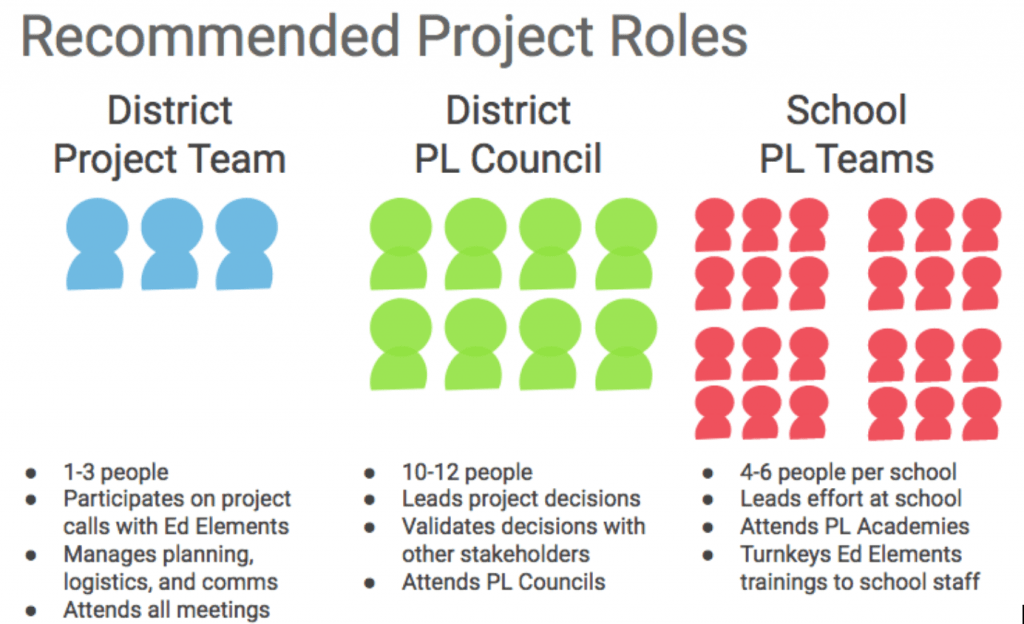How to rethink district roles to support blended and personalized learning
June 26, 2018 |
June 26, 2018 |
At Education Elements, we’re really lucky to support the design and implementation of blended and personalized learning across more than 700 schools and districts around the country. In this work, we’re often asked, “How do we set up teams to build our internal capacity and support the implementation, scale, and deepening of blended and personalized learning?”
We usually start by recommending that districts think about how to set up a layered support structure to create distributed leadership and a feedback loop between school and district teams. As pictured below, we think that most districts need to establish a core Project Team (typically 1-3 people) to drive the work forward day-to-day; a heterogeneous District Council (typically 10-12 people) to set strategy, provide diverse perspectives, and serve as a core decision-making body; and a School Personalized Learning (PL) Leadership Team (typically 4-6 people) at each school site to distribute leadership across the principal, coaches, and teachers, and lead the design and implementation of blended- and personalized-learning models.

For roles, define the work before the people
Our thinking about the best roles to support blended and personalized learning has continued to evolve. Education Elements CEO Anthony Kim and IDEO Principal Designer Alexis Gonzales-Black recently published a book, The NEW School Rules: 6 Vital Practices For Thriving and Responsive Schools, that has helped us to think about roles and accountabilities in new ways. The third chapter focuses on Rule #3: Define The Work Before You Define The People, and the authors share insights about how to structure teams and roles in a way that supports accountability and responsiveness.
When considering what work needs to be done, it’s important to differentiate between “job title” and “role.” We often think of our role as our job title, but roles are actually fluid and change frequently based on the needs of teams and organizations. Rethinking the relationship between roles, accountabilities, and people is an essential component in changing the way work gets done and decisions get made within and across teams.
This table below is an example of how districts often set up a Personalized Learning Team: they start with existing people and divvy up work based on what those individuals’ job titles suggest that they should do.
 In reality, however, the implementation of blended and personalized learning might demand very different types of roles and skill sets. Instead, we started asking district teams: what would happen if we started with the roles before adding in the people?
In reality, however, the implementation of blended and personalized learning might demand very different types of roles and skill sets. Instead, we started asking district teams: what would happen if we started with the roles before adding in the people?
The examples below show how two districts designed more specific and effective roles by defining the work before they defined the people. In both examples, the teams are responsible for leading a district-wide, personalized-learning initiative. Though they share a similar purpose, the roles look quite different based on each district’s distinct needs.
DISTRICT A
DISTRICT B
Getting at the goal behind these roles and the right team structures can help schools and districts shift their perspectives and priorities. I’ve had the chance to lead this roles work with a few dozen district leaders and asked a few to share why they wanted to rethink roles on their team and how this work supported them to better achieve their goals for personalized learning at schools.
As Ryan Fitzpatrick, Blended Learning Coach at Greeley-Evans School District 6 in Colorado shared, “Our team is taking on a challenging task this year: onboard the remainder of our schools into our blended-learning implementation and train all instructional coaches on blended learning best practices. We’re a team of only four, so we had to get creative about how we take on this challenge. Redesigning our roles allowed us to consider our collective strengths and how we bring those together to support the system as a whole.”
Duane Sheppard, Assistant Superintendent of Curriculum and Instruction at Yuma School District ONE shared the impact of this work. “Moving into a personalized-learning journey requires rethinking the roles that everyone plays from student to teacher to superintendent,” Sheppard said. “Our district went big and forged a path for 17 schools simultaneously. We knew right away that our traditional roles would become disrupted and new roles would need to evolve. Setting up new roles helped us stay focused on the vision of our personalized-learning journey without getting bogged down in the way things had always been. Rethinking roles has created an incredible team of collaborators.”
So now it’s your turn! If regrouping roles and accountabilities sounds exciting, but daunting, don’t worry—we’ve developed a simple “workout” to help get you more comfortable thinking about roles in this way. Use this exercise on your own or with your team to practice in a low-stakes environment before regrouping your team roles and accountabilities.
Keara is a Partner at Education Elements who focuses on how to build and scale a culture of innovation in large systems, how to create national communities of collaboration, and how to keep laughing when pursuing daunting, large-scale changes. She designed the toolkit for The NEW School Rules and is the author of The Kikibrief. Keara was born in rural, southern Oregon and currently lives in Denver. Share your questions, insights, and stories with Keara by tweeting @kearaduggan.
Leave a Reply